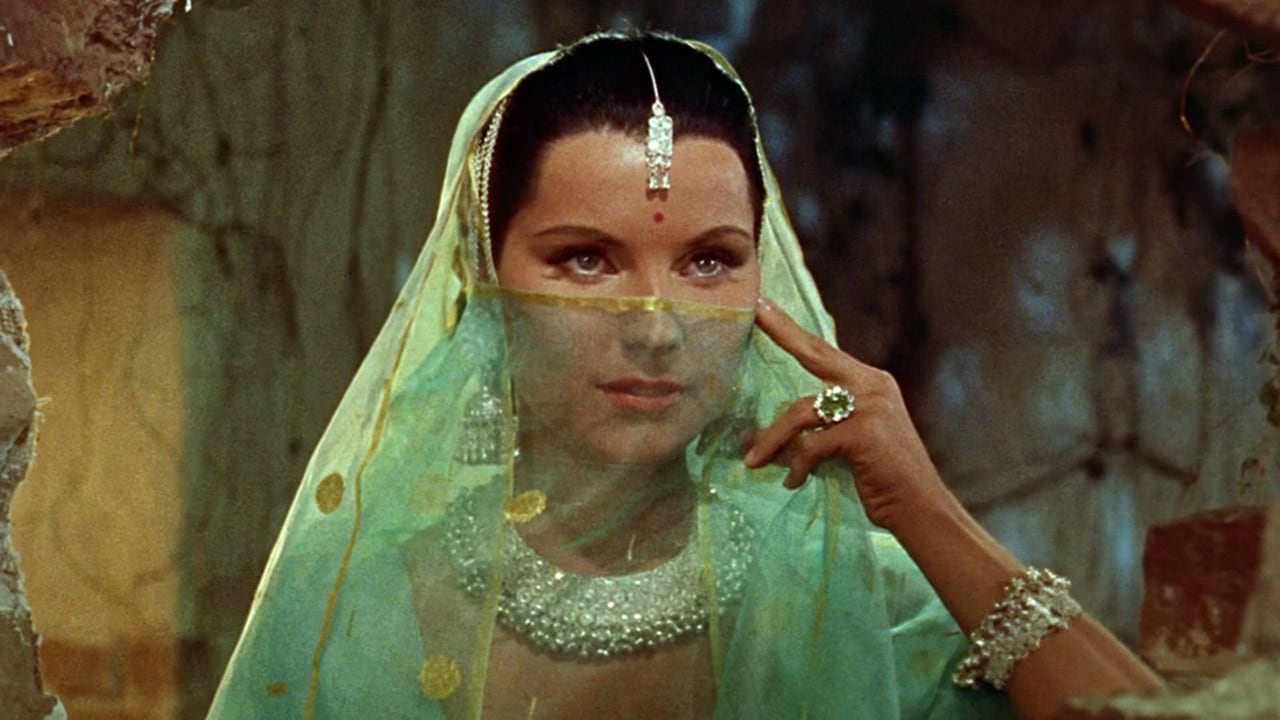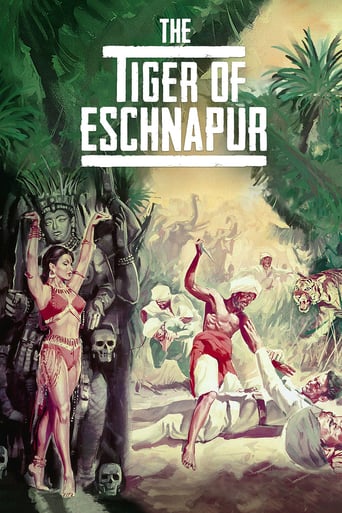

Fritz Lang is one of those directors who managed the transition from silent film to sound film, even if most people will probably argue that his best works come from the days when there was still intertitles in films to tell us what the characters were saying. "Der Tiger von Eschnapur" is one of the last films of Lang and he was already in his late 60s when he made this one and it's actually a remake of a film that Lang already made considerably earlier in his career. This is also why Thea von Harbou, a couple years dead already by 1959, is listed as the writer. She also worked on the script of the original black-and-white films. This one here is in color and the first 100 minutes from a duology that continues with "Das indische Grabmal", another 1959 film. The cliffhanger ending also indicates this.I personally did not enjoy the watch too much. It starts off fairly solid, the characters are interesting, but sadly it does not stay this way for the entire film. I quickly lost interest in the story of an architect falling in love with a dancer, a woman that the local Maharajah also has an interest in. It's a tale about love, power and deceit, but it's nowhere near as good as it could have been. Looks like Lang already had his best days behind him and I cannot say I have a whole lot of interest in seeing the sequel, although I probably will soon and I hope it's actually 100 minutes that are improved to the 100 minutes we have here. As for the 1959 version of "The Tiger of Eschnapur", I do not recommend watching it unless you're a Lang completionist. It's not a failure, but also it's not a good film. Thumbs down. Oh yeah and a quick note about the cast. Do not be fooled by the characters in the film and the dark skin makeup because pretty much the entire cast is German. of course the clean speaking with no accents in this film also gives them away.
... View MoreIf you're familiar with Fritz Lang, particularly his silent epics like "Dr. Mabuse, The Gambler," "Metropolis" and "The Nibelungen," and you admire the intricate plotting, attention to detail and fully flesh out worlds, his two-part Indian Epic (of which "The Tiger of Eschnapur" is the first part) will probably turn out to be a splendid surprise. This massive production has a lot going for it, not the least of which are the remarkable locations, cinematography, Langian screen compositions and stunning costumes. This is eye candy to the max with one amazing image after another, but its modern day Adam and Eve storyline and supernatural microcosm are also noteworthy. The first time I watched it, I think I found it rather slow and uneventful, but something about it brought me back about a year later. The second viewing was a very different experience. I saw things I completely missed the first time around. The clever irony, the emphasis on the spiritual world, the correlation of animals to the main characters and the Gods, the existence of a subversive underworld, and the interplay of opposing forces all came into focus in the most poetic fashion. I think it takes a second viewing to see how it all works. As someone else mentioned, the films are structured in a cliff hanger serial style, not unlike the Indiana Jones films. Unlike Spielberg, however, Lang's Indian Epic isn't afraid to take its characters seriously. There is humor, but the romance of character, locale, theme and story take a front seat. There is more going on here than just a fantastic adventure. I must also mention Debra Paget, who plays Seetha, a half-Indian, half-Irish dancer. She basically runs away with the whole show. I hadn't ever fully appreciated her until I saw her in this. She never radiated more beautifully than she does here and her two dances (one in each part of the film) are without a doubt among the most erotic ever photographed. Yet, they equally expand the full drama of the story. Lang's compositions speak volumes about the characters and an entire essay could be written about them. Suffice to say, even if the meaning of the shots don't hit you, you'll still be blown away by the exquisite colors, production design, and costumes. The use of white is astounding. Let me also mention the music by Michel Michelet. It's quite a stylish score, rich with exotic instrumentation, Indian marches and fanciful dances. Like the exquisite images, the score adds considerably to the alluring atmosphere. If you're a Fritz Lang fan, and you don't mind silent film pacing, you're probably of an age and mind-set to appreciate this epic. It made me wonder what Lang would have done with "Metropolis" had he shot it in 3-strip Technicolor, like this epic. There are some negatives I must mention, however. Some of the visual effects are less than satisfactory and a few of the sets look like it. Also, some of the Indian characters (Chandra, for example) are not Indians but white actors in makeup. Such were the times, but even as recently as 1982's "Ghandi," white actors (Ben Kingsley) were playing non- whites. Nevertheless, the broad strokes performances work well in this kind of adventure. The Fantomas DVD of Lang's Indian Epic has both German and English language available. Even though the dubbing is regrettable, the English version is preferable (unless you speak German), since the subtitles avert your eyes from the spectacular imagery. If you approach this with an open mind, Lang's Indian Epic will sweep you away to a wondrous world.
... View MoreI was wary of purchasing Fantoma's 2-Disc Set of "Fritz Lang's Indian Epic" after being somewhat let down by the 1921 Silent original (co-scripted by Lang himself) and also its less-than-stellar reputation. For this reason, when the second part of the saga turned up on Italian TV a couple of years ago, I decided to check it out just the same so as to get an inkling of what to expect! I recall thinking it pretty kitschy and unworthy of Lang's enormous talent, but Fantoma's sale (through their website) of their entire DVD catalog a few months back made it an irresistible acquisition! Well, having now watched the entire saga (with dialogue and in color, as opposed to the rather static Silent version directed by Joe May - although hearing the Indian-garbed characters talking in German took some getting used to), I was pleasantly surprised by how genuinely engaging and sheerly enjoyable it all was! Though it was sold as an epic production (to the point of concluding ESCHNAPUR with the promise that Part II would feature greater thrills and even more spectacle) at a time when such films were all the rage, the saga was actually a pretty modest undertaking by eclectic (and prolific) German producer Artur Brauner. Despite the two films' exotic, handsome look (not least in the provocative dances of Debra Paget), the budgetary constraints were painfully obvious in the special effects department, especially the hilarious appearance of a 'ropey' cobra which is intended to 'test' (the scantily-clad) Miss Paget's faithfulness to the Maharajah!! All in all, even if these films hardly constitute Lang's greatest work (though he harbored an evident affection throughout his life for this particular tale, which was originally conceived by his former wife Thea von Harbou), they have great - and enduring - appeal for aficionados of old-fashioned, serial-like adventure stories tinged with romance and mysticism.Even so, while I don't subscribe to that school of thought myself, there are some film critics (Tom Gunning, Jean Douchet and Pierre Rissient among them) who think very highly of Lang's Indian diptych - the first considering it one of Lang's towering achievements and the last two numbering it among the ten greatest films of all time!!
... View MoreFritz Lang's last American work " beyond a reasonable doubt" was a commercial failure and it was panned at the time -nowadays ,and mainly in Europe ,critics are inclined to reverse their opinions.Actually "beyond a reasonable doubt " could easily be "remade" (God preserve us!) today because its screenplay with the unexpected final twist is trendy(1) .Afterward,Lang returned to Germany and began to film what was an old plan of his (it was filmed ,but by other directors),written by his ex-wife Thea Von Harbou.The gap between "Der Tiger von Eschnapur" and "beyond a reasonable doubt" (and "human desire" "while the city sleeps" "clash by night" "the big heat" etc) seems so wide that a lot of people did not recognize "their " Fritz Lang.One could answer them that ,already in the mid-fifties ,Lang had adapted for the screen "Moonfleet" ,his first color experiment with startling results .And "Moonfleet" too did not seem to belong to Lang's canon."Moonfleet " was a tour de force because it was a whole story seen through a child's eye.Something magic was born ,and it's this magic we find again in "Der Tiger von Eschnapur"."Der Tiger von Eschnapur" is a 4 million marks movie and the most accessible of all Lang's works:it can appeal to a child as much as to a professor .At first sight,it appears as an adventure yarn ,close to comic strip ,some kind of "Fritz Lang and the temple of doom" ,but a director like him cannot be brought down to only that."Der Tiger von Eschnapur" is a visual splendor ,with an unusually inventive use of color,which is not unlike his British peer Michael Powell (Black orchid,thief of Bagdad).Lang was an architect ,and it's impossible not to feel it,here more than in his entire American period. It's no coincidence if his hero (Henri Mercier/Harald Berger) is an architect too;they are always holding and studying plans .Lang's camera perfectly captures the space it describes .Mercier (Paul Hubschmid)is often filmed in high angle shot,in the huge palace of the Maharajah,in the tiger pit ,or later,in the second part ,in the dungeon where he's imprisoned.Actually,and it's obvious,it takes us back to Lang's German silent era ,particularly "der müde Tod" "die Niebelungen" and "Metropolis"."Der Tiger von Eschnapur" is essentially a movie of exposition:some scenes which seem overlong (Paget's dance),irrelevant(the lepers ) are actually necessary to prepare the stage for part two.And this leads us to one of Lang's permanent features:the coexistence of two worlds.Behind the lavishly furnished palace,the sumptuous clothes,the sparkling jewels ,there's another world beneath.The scene when Mercier meets the lepers scrawling on the ground ,and in a simpler but no less harrowing ,Baharani's blood seeping out of the basket are hints at a darker side of the luminous magic world of Chandra.There's a lot to say about "der Tiger von Eschapur" :the flight through the desert recalls sometimes Henri -Georges Clouzot's "Manon" (1949),as Mercier's madness breaks out and he begins to fire at the sun."Der Tiger von Eschnapur" is a must.(1) it was finally remade and as expected it was a disaster
... View More